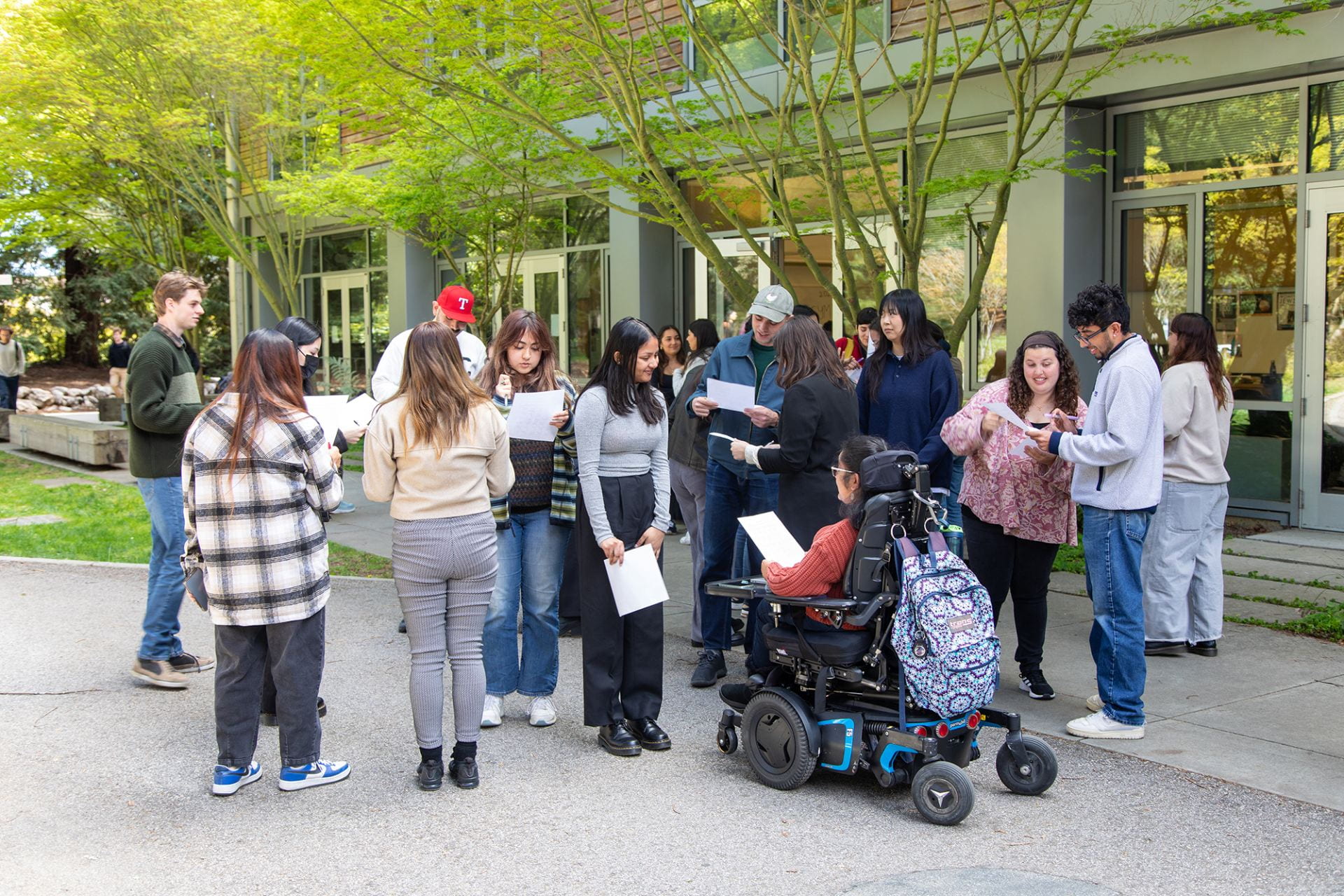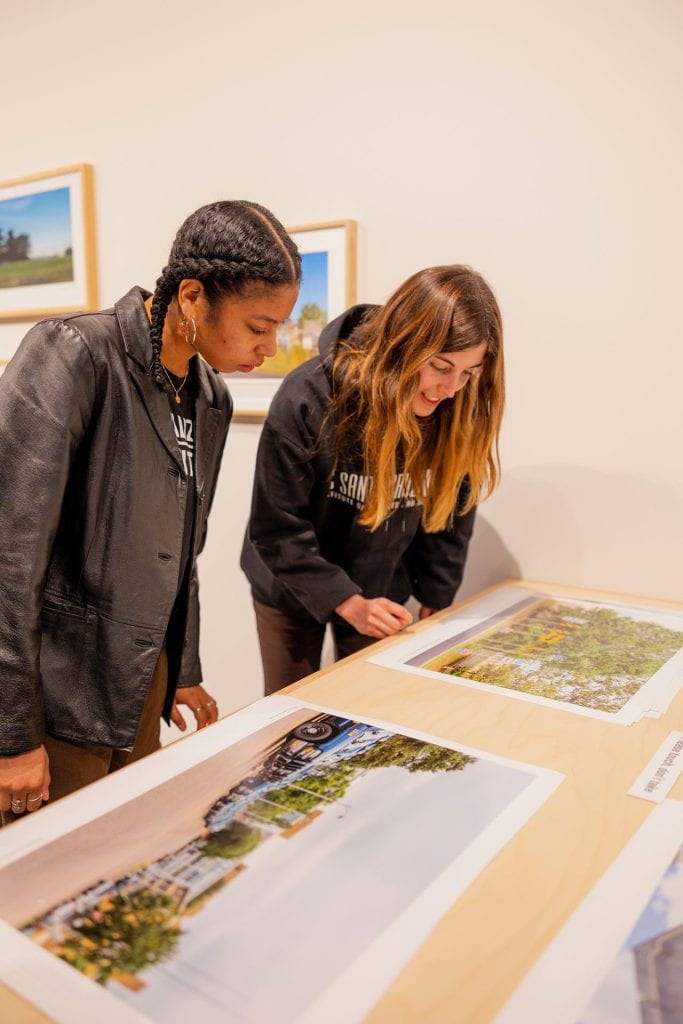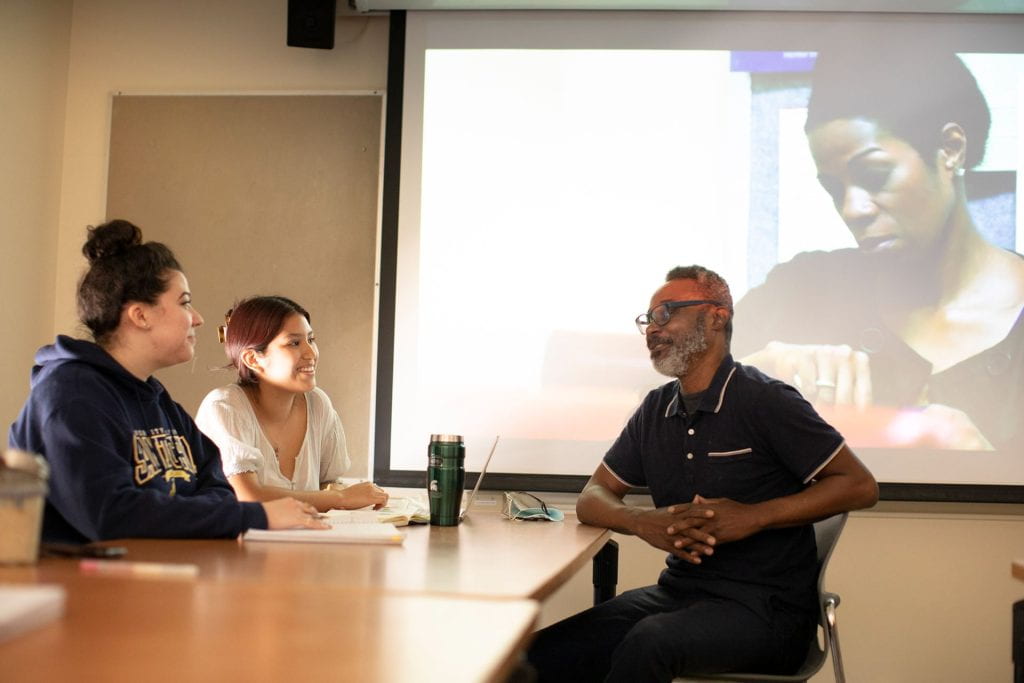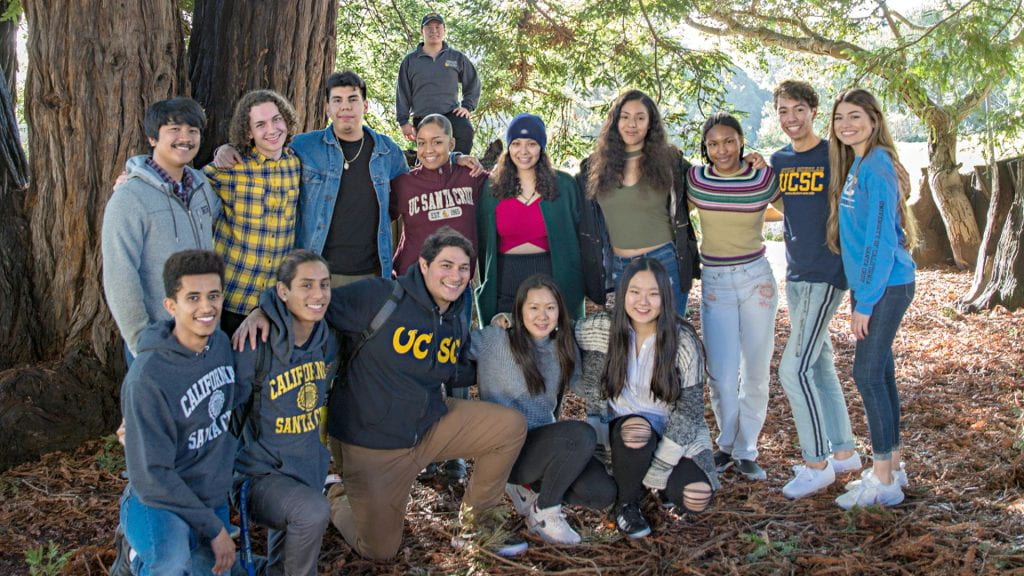
Inclusive and Thriving Campus Community
Committee members
Celine Parreñas Shimizu, Dean of Arts and Distinguished Professor, Film and Digital Media, co-chair
Anju Reejhsinghani, Vice Chancellor, Diversity, Equity and Inclusion, co-chair
Shiva Abbaszadeh, Associate Professor, Electrical and Computer Engineering
Needhi Bhalla, Associate Professor, Molecular, Cell, and Developmental Biology, and Science Faculty Equity Advocate
Jessica Bulleri, Campus Wellness Program Manager, Risk Services
Álvaro Cárdenas, Associate Professor, Computer Science and Engineering
Colette Chiriqui Grey, Manager, Talent Acquisition
Grace Peña Delgado, Associate Professor, History
Angel Dominguez, Graduate Services Counselor, Student Achievement and Equity Innovation
Patty Gallagher, Professor, Theatre Arts, and Arts Faculty Equity Advocate
Marcella Gomez, Associate Professor, Applied Mathematics and Associate Dean for Diversity, Equity and Inclusion, Baskin Engineering
Adrienne Harrell, Executive Director, UCSC Foundation
Karlton Hester, Professor, Music, Director of Digital Art and New Media, Director of Jazz Studies, and Associate Dean for Diversity, Equity and Inclusion, Arts
Christine Hong, Chair of Critical Race and Ethnic Studies, director of the Center for Racial Justice at UC Santa Cruz, and Associate Professor of Literature
Nancy Kim, Executive Director, Resource Centers, Student Affairs and Success
John Jota Leaños, Professor, Film and Digital Media and Arts Faculty Equity Advocate
Herbie Lee, Vice Provost for Academic Affairs and Professor of Statistics
Heather Lefebvre, Human Resources Manager, ITS – Resource Planning and Management
Yat Li, Professor, Chemistry and Biochemistry
Judit Moschkovich, Professor, Education and Associate Dean for Diversity, Equity and Inclusion, Social Sciences
Psi Padhya, Undergraduate student representative
Ravi Rajan, Professor, Environmental Studies
Ana Christina Ravelo, Distinguished Professor, Ocean Sciences, and Associate Dean for Diversit y, Equit y and Inclusion, Physical and Biological Sciences
Lenora Willis, E xecutive Director for African, Black, Caribbean Student Success
Staff support
Asia Valdivia, Special Assistant and Project Manager, Office for Diversity, Equity, and Inclusion
Committee Charge
We seek to embed principles of diversity, equity, and inclusion because we aspire to extraordinary outcomes in research, scholarship and creative activities, teaching, and other related pursuits. Excellence can only be achieved when the members of our campus community feel respected, valued, and welcomed. The committee was tasked with creating opportunities for faculty, staff, and students to discuss how the campus should approach improving the diversity, equity, and inclusivity of our campus as reflected in its overall climate over the next decade. The committee considered the following as part of its recommendations: • Evaluating and learning from our UC peers, CSUs, community colleges, and other public education institutions in California and nationwide.
The committee considered the following as part of its recommendations:
- Inventorying the emerging campus ecosystem of units and leaders for equity, belonging, and inclusion, including the Office for Diversity, Equity and Inclusion (ODEI); Equity and Equal Protection; Academic Personnel Office; Hate/Bias Response Team; and the newly re-established Ombuds Office, and propose recommendations to address real and perceived institutional, programmatic, and other equity-related gaps as well as cultures of exclusion.
- Taking stock of the Diversity, Equity and Inclusion (DEI) committees, positions, leaders, and other initiatives (including grant-funded) developed outside central campus offices, including evaluating their effectiveness and recommending how to leverage, amplify, and support this work.
- Reviewing current required and optional DEI-related training for students, faculty instructors, teaching assistants, and other academic and non-academic staff and making recommendations for improvements and needed resources.
- Recommending best practices to improve diversity (in all its facets) in faculty, staff, and student hiring in consultation with the Vice Provost of Academic Affairs, Faculty Equity Advocates, and Staff Human Resources, among others.
- Proposing mechanisms to conduct larger campus conversations and action plans to ensure an inclusive campus community, recommend clearer pathways to support those experiencing noninclusive behaviors, and hold each community member accountable to our values in the face of ruptures.
- Improving communication flows at departmental, divisional, and campus levels on the importance of contributions to diversity, equity and inclusion, and inclusive teaching, especially concerning the transparency of their value in the merit review process.
When asked what strategies UC Santa Cruz should focus on to become a more inclusive and welcoming place for students, the top priorities were:
- Helping low-income and minoritized students access community resources
- Expanding on-campus mental health services
- Making the campus more inclusive and welcoming for students with disabilities
- Making the campus welcoming for students of color more inclusive and welcoming for students of color
- Providing additional academic advising services

Goals
Goal 1: Improve faculty and staff hiring and review
Improve the hiring practices for faculty, staff, and students to align with research-based best practices for inclusion and fairness. Improve review/appraisal practices for faculty and staff to be more equitable, transparent, and consistent across time and settings, and, in particular, to improve how contributions to diversity, equity, and inclusion are documented, assessed, and recognized.
Transparency, expert mentoring, and staff support before, during, and after the review/appraisal process are important for building a longlasting culture that values inclusion, fairness, diversity, and equity.
There are many research-based approaches for improving inclusive faculty hiring. A top priority is improved training for search committees and department faculty in discussing, trying out, and implementing such methods. The current processes for faculty hiring already center on contributions to diversity, equity, and inclusion. The Faculty Equity Advocates are working on the next generation of fair hiring training materials and should be supported in that effort.
For faculty reviews, some areas for exploration are:
- How teaching inclusivity is documented, assessed, and recognized (perhaps using department-developed rubrics or revising rubrics available from the Teaching and Learning Center)
- Documenting, including, and assessing DEI contributions in teaching, service, or research
- Expanding definitions of research productivity to include community-engaged, digital, or public scholarship, and practitioner-oriented publications
- Addressing whether contributions to diversity are a separate fourth category or are integrated into the assessment of each of three current categories (i.e., research, teaching, service)
- Addressing how the different categories (whether 3 or 4) are weighted
The campus Fair Hiring Guide provides information and resources for staff hiring, and there is an online training module and a systemwide Implicit Bias Series. However, these are not required. Search committees would benefit from additional support and a requirement to complete the training module and bias series every two years. The campus should explore creating a Staff Equity Advocate program akin to Faculty Equity Advocates.
For staff reviews, campus guidance needs to be developed on the inclusion of contributions to DEI. Training should also be developed to help supervisors include and effectively evaluate these contributions.
In alignment with research-based best practices, another recommendation that benefits faculty and staff hiring is dedicating central funds for campuswide prepaid advertising to create a pool of applicants that reflects the diversity of applicants’ fields. All jobs would automatically be posted to predefined venues with the purpose of enhancing strategies to increase diversity equitably across campus.
Because the student hiring process is extremely decentralized, it is difficult to influence that process. Training materials and guidelines might be better distributed, and additional resources may be required for outreach and distribution. In particular, faculty may need more support and training to learn best practices for hiring students. Successful hires can depend on helping the students develop a sense of belonging. The Career Success Supervision Toolkit provides resources for mentoring student employees. It may be helpful to explore the creation of a staff position to work with faculty and staff during the hiring process to improve inclusive and fair practices for student recruitment and hiring.
Metrics
- Ensure that hiring and review/appraisal guidelines are aligned with the campus vision and that DEI contributions are included in hiring and reviews/appraisals. Consider adding “contributions to DEI” as a standalone fourth category in faculty review.
- Use and build on research-based best practices, including relying on our staff, faculty, and other experts. Expand definitions of “research” and “scholarship,” and abide by the credo, “Nothing about us without us.” For example, moving from a culture that “accommodates” disability and chronic illness to one that incorporates access into every aspect of the university experience.
- Supply written materials and make them easily accessible and searchable. Provide multiple opportunities and settings for discussion (e.g., scenarios, small groups, long-term study groups, reflection, and self-improvement) and develop sufficient resources (e.g., funding, time, staffing, organizational support, professional facilitation, and consultation with the Academic Personnel Office and Staff Human Resources).
- Consider establishing a Staff Equity Advocate Program akin to the Faculty Equity Advocate Program, and dedicate central funds for advertising positions to a diverse applicant pool.
- Regularly revisit and assess how the improvement process moves forward.
Goal 2: Inventory, integrate, and embed DEI into the campus culture
Establish clear goals and expected outcomes and improve transparency, clarity, and alignment of DEI expectations and opportunities. Bolster ODEI and divisional DEI roles and offices, growing their capacity to collaborate with campus partners and serve as a nexus for campuswide and divisional DEI efforts, respectively. Propose mechanisms to conduct more extensive campus conversations and action plans to ensure an inclusive campus community, recommend clearer pathways to support those experiencing non-inclusive behaviors, and hold each community member accountable to our values in the face of ruptures.
UCSC should develop a tool for gathering and assessing information about DEI efforts in academic and non-academic units with the assistance of the Academic Senate, Staff Advisory Board (SAB), Graduate Student Association (GSA), and Student Union Assembly (SUA). Given the sheer volume of work that has been conducted but only sometimes shared widely, we need to develop more concerted coordination among ODEI, Institutional Research, Assessment, and Policy Studies (IRAPS), and other entities on campus seeking to do data gathering, analysis, and communication in the DEI space. Additionally, we support expanding DEI data gathering and analytical capacity to expand collaboration across campus in the DEI research and planning space.
The Chancellor’s empowerment of the ODEI with the hiring of our first Vice Chancellor of DEI, the new Associate Vice Chancellor of Equity and Equal Protection, and the new University Ombuds, elevates the importance of these needed units and prioritizes belonging on campus. Additionally, the Academic Personnel Office, Hate/ Bias Response Team, and Behavioral Intervention Team (BIT) of the Office of Risk and Safety Services address real and perceived institutional, programmatic, and other equityrelated gaps and cultures of exclusion. These offices should be fully staffed to avoid delays in responding to compliance needs and addressing climate concerns. Additionally, we should consider connecting our Principles of Community to campus policies to go beyond compliance when developing strategies to improve our climate.
As members of our community, we must be able to trust in our protocols, processes, and systems for addressing any issues of discrimination, harassment, assault, or campus climate. Trust in our systems is enabled in our community’s learning that problems are being addressed, solutions enacted, and trends identified to improve our processes and protocols. Behaviors that do not rise to policy violations should nonetheless be tracked in how they contribute to a hostile working environment, including where there are frequent occurrences by the same person. The need for Counseling and Psychological Services (CAPS) to support students who engage with the reporting process is critical to recognize so that they may be well-resourced in addressing DEI issues on campus. To ensure confidentiality while modeling transparency, there should be proactive communication around policies and procedures to assure communities affected by complaints and grievances that disciplinary and other investigatory actions have taken place.
Metrics
- Build on existing efforts to gather and assess data in the DEI space and inventory existing resources on campus. Develop a DEI inventory with the assistance of SUA, GSA, SHR, and Academic Senate.
- Fully staff ODEI, EEP, Ombuds, APO, Hate/Bias, and BIT and build collaboration among these units and others.
- Document the entire ecosystem of DEI activities on ODEI’s website to serve as a way for campus members to contact organizers or stakeholders based on search parameters.
- Embrace transparency whenever possible without violating the confidentiality of our processes. Regularly report the work of compliance offices so that our community knows that problems are being addressed expertly and in a reasonable time frame.
- Tackle the “culture of avoidance” that currently characterizes conflict management processes when there is inadequate trust in institutional decision-making. Track behaviors that contribute to hostile work environments even when they are not at the level of policy violations.
- Expand mental health resources for faculty, staff, and students. Building on the Behavioral Intervention Team (BIT), Campus Safety Community Advisory Board (CAB), and Counseling and Psychological Services (CAPS), create an ecosystem of care and community response that addresses the individual and collective impacts of ongoing inequities.
Goal 3: Develop DEI learning pathways and integrate accountability frameworks
Develop a comprehensive metric to track and assess DEI programs. Create more cohort-based learning pathways with reasonable time to completion and appropriate scheduling. Scaffold learning opportunities to entail growth and avoid U.S.-centric perspectives. Ensure that sufficient resources and incentives exist for developing, assessing, and participating in learning opportunities.
UCSC’s current DEI professional development resources are growing but remain scattered and primarily optional in nature outside of the hiring context. The university should consider using a comprehensive metric to better track and assess DEI progress over time. Identifying appropriate metrics for each campus population should be informed by their respective policies and DEI best practices and documented with clear and transparent goals.
At present, students are the only group with mandatory DEI training. We Are Slugs! is an online asynchronous training for incoming students. Additional learning opportunities for both undergraduate and graduate students are available from F.R.E.D. (Facilitators for Race and Ethnic Diversity), currently funded and sustained through the African American Resource and Cultural Center by annual funding requests to the Student Fee Advisory Committee Call for Funding Proposals; and from LinkedIn Learning.
There is no required DEI training for all staff, though hiring search committee members are required to complete the online Managing Implicit Bias series required of faculty members serving on search committees.
Feedback indicates that one-off workshops such as these are not viable solutions. For several years, ODEI has provided the Diversity & Inclusion Certificate Program (DICP) to faculty and staff members. While interest in the program remains high, the time to completion is up to two years, and courses are scheduled at inconvenient times for faculty. Additionally, participants must complete the same introductory courses regardless of prior academic or professional experience. (The program is on pause in 2023–24 as ODEI assesses and reimagines its DEI professional development programming.)
Models of equity learning should be offered with intentionality for different cohorts. For instance, we support incorporating DEI learning into the Core Course for incoming first-year students and onboarding training for graduate student employees, similar to what the Teaching and Learning Center offers for new incoming faculty for foundational learning. Faculty and scholars who were socialized or educated outside the United States may need additional DEI offerings that take international context into consideration. Many members of domestic marginalized groups respond differently to introductory-level DEI programs than those with only a base level of understanding. Nor can we assume intersectional understanding exists across marginalized populations. DEI offerings can emphasize solidarities while recognizing potential intergroup challenges, such as colorism, casteism, bias on socioeconomic lines or based on academic pedigree, and privileges of U.S. citizenship or legal residence within mixed-status communities.
Metrics
- Commit to personal and professional growth through DEI learning opportunities, which should be an expectation of every community member, including faculty, staff, students, leadership, and volunteers. Every campus member should participate in an equity assessment to evaluate their level of knowledge.
- Consider individuals’ respective work environments and roles in their DEI professional development. Managers and supervisors should encourage relevant professional development among their teams and prioritize improving the overall climate in their units. Staff and students should have opportunities to engage in appropriate DEI learning during school or work hours.
- Offer sustained funding for internal and external programs such as F.R.E.D., Academic Impressions, LinkedIn Learning, and other programs. Such opportunities should be more equitably available to all employees.
- DICP (or subsequent programs in ODEI) should offer introductory, intermediate, and advanced professional development for faculty, staff, and students, and instructors/facilitators should receive compensation for their time.
- Create DEI-related learning experiences in cohort form to provide a shared community expectation about how goals will apply going forward. Learning opportunities should be offered in a scaffolded manner for all learner levels and continuously for ongoing development.
Goal 4: Address barriers to retention for marginalized faculty, staff, and students
Proactively support retention efforts for faculty and staff from marginalized identities. Recognize the burden of identity taxation and build in expectations for DEI priorities for all employees.
UC Santa Cruz stated that a key goal in its faculty recruitment efforts is to increase the percentages of faculty of color, women, LGBTQ+, and individuals with disabilities by 2030. Similarly, we support recruiting and retaining a diverse staff. Key to these efforts are intentional steps to reduce identity taxation, build community, and send a clear signal when climates need to change to become more inclusive.
Our findings suggest that centering joy is essential to the success of marginalized groups, both through structured activities and events and by coming together in community. This does not happen in a vacuum. Holding events to celebrate our campus’s diversity is a priority supported by our survey data, but so is the importance of providing affinity group spaces for populations currently without access to them. Yet creating community is only one step in helping to build retention. Ensuring healthy climates for all employees is central to a longer-term strategy.
Microaggressions or other instances of bias against BIPOC, LGBTQ+, or otherwise marginalized employees by students and colleagues alike must be addressed swiftly to reduce future disengagement or risks of early departures. Employees needing religious and/or disability accommodations should be more holistically taken into account when building welcoming climates. In all ways, DEI metrics must move beyond the performative to ensure that deeper work is rewarded in promotions and advancements, particularly given potential issues around salary equity. In some cases, previous hurtful incidents that disproportionately impacted marginalized populations merit institutional reckoning. And administrative and curricular policies, procedures, and priorities must be reassessed through the lens of equity and inclusion whenever possible.
Metrics
- Build community among and between marginalized groups to help shore up employee morale and center joy.
- Intentionally recognize the identity tax imposed on many marginalized faculty and staff and work to ensure a more equitable model of DEI work by all employees.
- Examine salary equity issues disproportionately affecting marginalized faculty.
- Consider how DEI is prioritized in faculty recruitment, retention, and promotion.
- Evaluate DEI training across all ranks and levels, including an emphasis on our Community Principles and shared mission.


Goal 5: Support opportunities to connect university members to one another and the wider community
Provide opportunities for students to engage in debate and discussion outside of the classroom. Build more pipelines to community audiences and collaborators. More forcefully reckon with our local and regional histories of genocide, racism, xenophobia, and exclusion and support efforts to tell the stories of our marginalized community members.
UCSC should strive to strengthen connections among and between student groups, staff support networks, and faculty networks as a priority for community building on campus. For instance, it might revive student debate as a method to provide undergraduates with a learning opportunity to respectfully engage in public domains, including local governments, state bodies, and elsewhere. Divisions and departments can continue to organize student fora in leadership councils, town halls, or elsewhere. Moreover, the collegiate system on which the campus was founded offered great extracurricular opportunities in the early years of our campus. It might be time to reimagine how to foster the capacity for public debate.
Additionally, the university should support more projects connecting the university with local and regional community audiences. Recent examples of these efforts include a Humanities Division event at the Museum of Art and History on Japanese American history, the National Endowment for the Humanities–supported Watsonville Is In the Heart collaboration, and the work of the African American Theater Arts Troupe in the Arts Division.
Beyond community outreach, the university should strengthen regional pipelines from the university to the community in the form of permanent budget line items for this work across all units on campus. For instance, the statewide report on Black reparations provides opportunities to broaden our campus members’ understanding of reparations as an anti-imperialist, anti-racist concept. The legacies of genocide, racism, xenophobia, and exclusion — and of the resistance and resilience of those who persevered — should be addressed more forthrightly through community partnerships.
The group acknowledged several challenges to achieving these goals, including limited funding, resistance to change, and the need for more awareness and support. To overcome these challenges, the group recommended leveraging existing resources and partnerships, engaging stakeholders in the process, and communicating the importance of DEI work to the campus community.
Metrics
- Support community-building events such as public fora, town halls, and leadership councils that unite our university leadership, faculty, staff, and students.
- Foster pipeline projects that connect the university with regional and local communities.
- Amplify efforts to celebrate the work and achievements for which our campus and region should be known.
- Identify local and regional histories that need to be archived and historicized in the self-understanding and self-presentation of the campus, such as building awareness that Santa Cruz was a transit location to the Bay Area and Oakland during the Great Migration, exploring the influence of the Black Liberation Front on and off campus in the late 1960s, and investigating legacies of racism and xenophobia.
- Develop more funding for creative solutions that can increase collaboration and address areas of unmet need.
